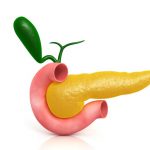To many of us in the west, Jiaogulan is not a name on many people’s lips. It is a traditional food and tea from China which is derived from Gynostemma pentaphyllum (Thunb.) Makino (Wang & Luo, 2007). Over the last few decades, the consumption of G. pentaphyllum, which is a perennial liana plant, has been steadily increasing since growing evidence indicated that this plant may potentially reduce the risk of cardiovascular diseases (Tanner et al., 1999). Other properties include:-
- Presentation of hypoglycaemic benefits which might make it suitable for blood sugar management (Yeo et al., 2008).
- Reduction in inflammation (Lin et al., 1993)
- Liver or hepatoprotection activity (Chen et al., 2009b)
- Anti-cancer (Chen et al., 2009a; Lu et al., 2008b)
Many of the plant’s properties are derived from a group of compounds called gypenosides which are saponins and a variety of flavonoids. New saponins are being uncovered all the time and are adding to the 170 gypenosides already discovered in this plant.
Nagai and his team discovered the first two (Nagai et al., 1981). Two were found by Yang and his group to reduce inflammation and to possible inhibit an enzyme called alpha-glucosidase (Yang et al., 2013).
The neutral polysaccharides extracted from the plant appear to have anti-cancer and immunoregulatory activity which was conducted in mice (Liu et al., 2014). The polysaccharides appear to have special properties overall. One labelled GPP1 was found to have a neuroprotective effect in certain cell lines and to protect them from cell death or apoptosis (Jia et al., 2015).
The liver protective effect is possibly helped by the presence of some triterpene saponins which reduce fibrosis of these liver cells (Shi et al., 2018).
The plant is grown widely in China and there is now growing interest in its horticultural promise in the USA.
Toxicity: low if any presentation at all (Attawish et al., 2004; Schild et al., 2010).
References
Attawish, A., Chivapat, S., Phadungpat, S., Bansiddhi, J., Techadamrongsin, Y., Mitrijit, O., et al. (2004). Chronic toxicity of Gynostemma pentaphyllum. Fitoterapia, 75(6), pp. 539–551
Chen, J.-C., Lu, K.-W., Tsai, M.-L., Hsu, S.-C., Kuo, C.-L., Yang, J.-S., et al. (2009a). Gypenosides induced G0/G1 arrest via CHk2 and apoptosis through endoplasmic reticulum stress and mitochondria-dependent pathways in human tongue cancer SCC-4 cells. Oral Oncology, 45(3), pp. 273–283.
Chen, M. H., Wang, Q. F., Chen, L. G., Shee, J. J., Chen, J. C., Chen, K. Y., et al. (2009b). The inhibitory effect of Gynostemma pentaphyllum on MCP-1 and type I procollagen expression in rat hepatic stellate cells. Journal of Ethnopharmacology, 126(1), pp. 42–49
Jia, D., Rao, C., Xue, S., & Lei, J. (2015). Purification, characterization and neuroprotective effects of a polysaccharide from Gynostemma pentaphyllum. Carbohydrate Polymers, 122, pp. 93-100. https://doi.org/10.1016/j.carbpol.2014.12.032
Lin, J. M., Lin, C. C., Chiu, H. F., Yang, J. J., & Lee, S. G. (1993). Evaluation of the anti-inflammatory and liver-protective effects of Anoectochilus formosanus, Ganoderma lucidum and Gynostemma pentaphyllum in rats. The American Journal of Chinese Medicine, 21(1), pp. 59–69
Liu, J., Zhang, L., Ren, Y., Gao, Y., Kang, L., & Qiao, Q. (2014). Anticancer and immunoregulatory activity of Gynostemma pentaphyllum polysaccharides in H22 tumor-bearing mice. International journal of biological macromolecules, 69, pp. 1-4. https://doi.org/10.1016/j.ijbiomac.2014.05.014
Lu, H. F., Chen, Y. S., Yang, J. S., Chen, J. C., Lu, K. W., Chiu, T. H., et al. (2008a). Gypenosides induced G0/G1 arrest via inhibition of cyclin E and induction of apoptosis via activation of caspases-3 and -9 in human lung cancer A-549 cells. In Vivo, 22(2), pp. 215–221.
Lu, K.-W., Tsai, M.-L., Chen, J.-C., Hsu, S.-C., Hsia, T.-C., Lin, M.-W., et al. (2008b). Gypenosides inhibited invasion and migration of human tongue cancer SCC4 cells through down-regulation of NFjB and matrix metalloproteinase-9. Anticancer Research, 28(2A), pp. 1093–1099
Nagai, M., Izawa, K., Nagumo, S., Sakurai, N., & Inoue, T. (1981). Two glycosides of a novel dammarane alcohol from Gynostemma pentaphyllum. Chemical and Pharmaceutical Bulletin, 29, pp. 779–783.
Schild, L., Chen, B. H., Makarov, P., Kattengell, K., Heinitz, K., & Keilhoff, G. (2010). Selective induction of apoptosis in glioma tumour cells by a Gynostemma pentaphyllum extract. Phytomedicine, 17(8–9), pp. 589–597.
Shi, G., Wang, X., Zhang, H., Zhang, X., Zhao, Y (2018) New dammarane-type triterpene saponins from Gynostemma pentaphyllum and their anti-hepatic fibrosis activities in vitro. J. Functional Foods 45 pp. 10-14 https://doi.org/10.1016/j.jff.2018.03.016
Tanner, M. A., Bu, X., Steimle, J. A., & Myers, P. R. (1999). The direct release of nitric oxide by gypenosides derived from the herb Gynostemma pentaphyllum. Nitric Oxide, 3(5), pp. 359–365
Wang, Z., & Luo, D. (2007). Antioxidant activities of different fractions of polysaccharide purified from Gynostemma pentaphyllum Makino. Carbohydrate Polymers, 68(1), pp. 54–58
Xie, Z., Huang, H., Zhao, Y., Shi, H., Wang, S., Wang, T. T., … & Yu, L. L. (2012). Chemical composition and anti-proliferative and anti-inflammatory effects of the leaf and whole-plant samples of diploid and tetraploid Gynostemma pentaphyllum (Thunb.) Makino. Food chemistry, 132(1), pp. 125-133. https://www.sciencedirect.com/science/article/pii/S0308814611014932 https://doi.org/10.1016/j.foodchem.2011.10.043
Yang, F., Shi, H., Zhang, X., Yang, H., Zhou, Q., & Yu, L. L. (2013). Two new saponins from tetraploid jiaogulan (Gynostemma pentaphyllum), and their anti-inflammatory and α-glucosidase inhibitory activities. Food Chemistry, 141(4), pp. 3606-3613. https://doi.org/10.1016/j.foodchem.2013.06.015
Yeo, J., Kang, Y. J., Jeon, S. M., Jung, U. J., Lee, M. K., Song, H., et al. (2008). Potential hypoglycemic effect of an ethanol extract of Gynostemma pentaphyllum in C57BL/KsJ-db/db mice. J. Med. Food, 11(4), pp. 709–716.


Leave a Reply